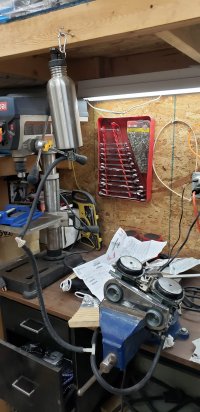We noticed you are blocking ads. DO THE TON only works with community supporters. Most are active members of the site with small businesses. Please consider disabling your ad blocking tool and checking out the businesses that help keep our site up and free.
You are using an out of date browser. It may not display this or other websites correctly.
You should upgrade or use an alternative browser.
You should upgrade or use an alternative browser.
Cb360 fuel in the oil?
- Thread starter Sderbyshire
- Start date
MotorbikeBruno
Over 1,000 Posts
Hell to the yes. Case closed!
Djfob
Been Around the Block
Bringing back a thread from the dead with the same issue, went through it all and everything looks good. I'm boggled in how in how in how feel is getting into the oil.Thanks for all the input guys!
I will remove and inspect the carbs at the weekend.
The bike runs well, and it really does seem that the oil level rises on even a brief run.
Nothing comes out of the overflows
The carbs are not the originals, were supplied with the bike which was a half completed project.... So I suspect this problem has always been there with these carbs.
I will check:
Overflows blocked?
Float valves clean/ridged
Test setup on bench without valves to check overflows
Test setup on bench with valves
Will post an update , prob with pics to assist diagnosis!
Thanks again
Steve
Petcock works as it should
Seat valve looks good, seat is clean
Overflows work.
Have it on the bench right now with an aux tank and no leaks anywhere so it has to be entering while the bike is running. I'm tempted to just get new oem seat valves to see if it fixes my problem.
Attachments
Sorry for Franken-threading, but I have a relevant add.Sorry guys, the stock Keihins on the 360 dont work that way. The bowl drain screw simply drains w the screw. The overflow w drain tube is separate.
cant check fuel level w a tube. (god knows I wish I could.)
As long as the overflow tubes are clear and functional and the bike is parked on remotely level ground fuel cant seep into the engine.
Ive had fuel POURING out my overflows. When an aftermarket float needle had burrs on it, preventing it from closing at all.
I have a 76 cb360t with the 754A carb and have been struggling with the issue of the carbs being over full, fuel in oil, and not being able to check the fuel level with a clear tube, and I came up with a solution.
Gas was leaking from 1 of the overflows, but as I tapped on the carb body, it would stop. The other overflow never leaked. This likely lead to fuel flowing into the carb throat and into the engine and getting into the oil.
This is what I did to verify the fuel level in the carbs.
I built a basic bench mount using scrap wood to get the carbs in the air, then used zipties to secure to the mount. I used shims to level the top of the carbs both side to side and front to back, to get it close.
Method for verifying fuel level (without clear tube method)
1. Check float height with the angle method as previously described. Set at recommended height, for me that was 20mm. This is the starting point.
2. Reinstall the carb bowels with 2 screws only, in opposite corners, without the gaskets, and put 2mm washers on the screws between the carb bowl and carb body to create a 2mm gap. Make sure washers are as close to out of the carb as possible to not interfere with the float operation. (My first attempt the washer blocked the function of the floats, and they didn't move. Oopsie.)
3. mount carb on bench bracket with zipties and level
4. Using a flashlight peek through the gap to see the floats. (These will move up when fuel fills the bowl. If they don't move something is out of alignment or the floats are shot. Can check freeness with a gentle poking using a pick tool or feeler gauge)
5. Connect auxiliary fuel tank, Open fuel line, and watch for float to raise. Be sure to have a container to catch overflow fuel. Wait for carb bowls to fill and watch for fuel spilling out of the gap. Shut off fuel line once fuel starts spilling.
6. Interpretation of Results
Fuel spilled out - if fuel rises floats, and fuel comes out of the gap made by the washers, that means the floats did not stop the fuel leading to over filling, and floats need to be adjusted up (more millimeters on angle adjustment) to lower fuel level in carb.
Fuel did not spill out - if fuel raises floats, and NO fuel comes out of the gap made by the washers, that means the floats stopped the fuel flow somewhere below the 2mm line. Float height needs to be adjusted down (less millimeters on the angle adjustment) to raise fuel level in carb. (Will want to raise fuel level untill it spills out then back off again to ensure fuel level is high enough)
7. Remove carbs from bench bracket and make appropriate float height adjustments. Change float heights by 1mm at a time to be precise and not overshoot the mark
8. Reassemble bowels with washers. Go to step 3 And repeat until fuel stops just below the lip of the float bowl and doesn't spill out. This will give you a fuel level in the carb of about 3mm (2mm washer + 1mm fuel didn't overflow) below the lip of the bowl.
9. Done
For me this really changed the performance of the motorcycle. I had the 100 secondary jet in, and since the engine wasn't being flooded with fuel, so I needed to change the jets back to the bigger stock jets 110 secondary to get it running smoothly.
If you want a fuel level a little higher, you could use a different thickness washer for creating the gap. Probably would make it hard to see the floats moving, but would still allow the fuel to spill as the indicator of fuel level.
I hope this helpS a person or two that may be struggling with fuel levels in this carb.






